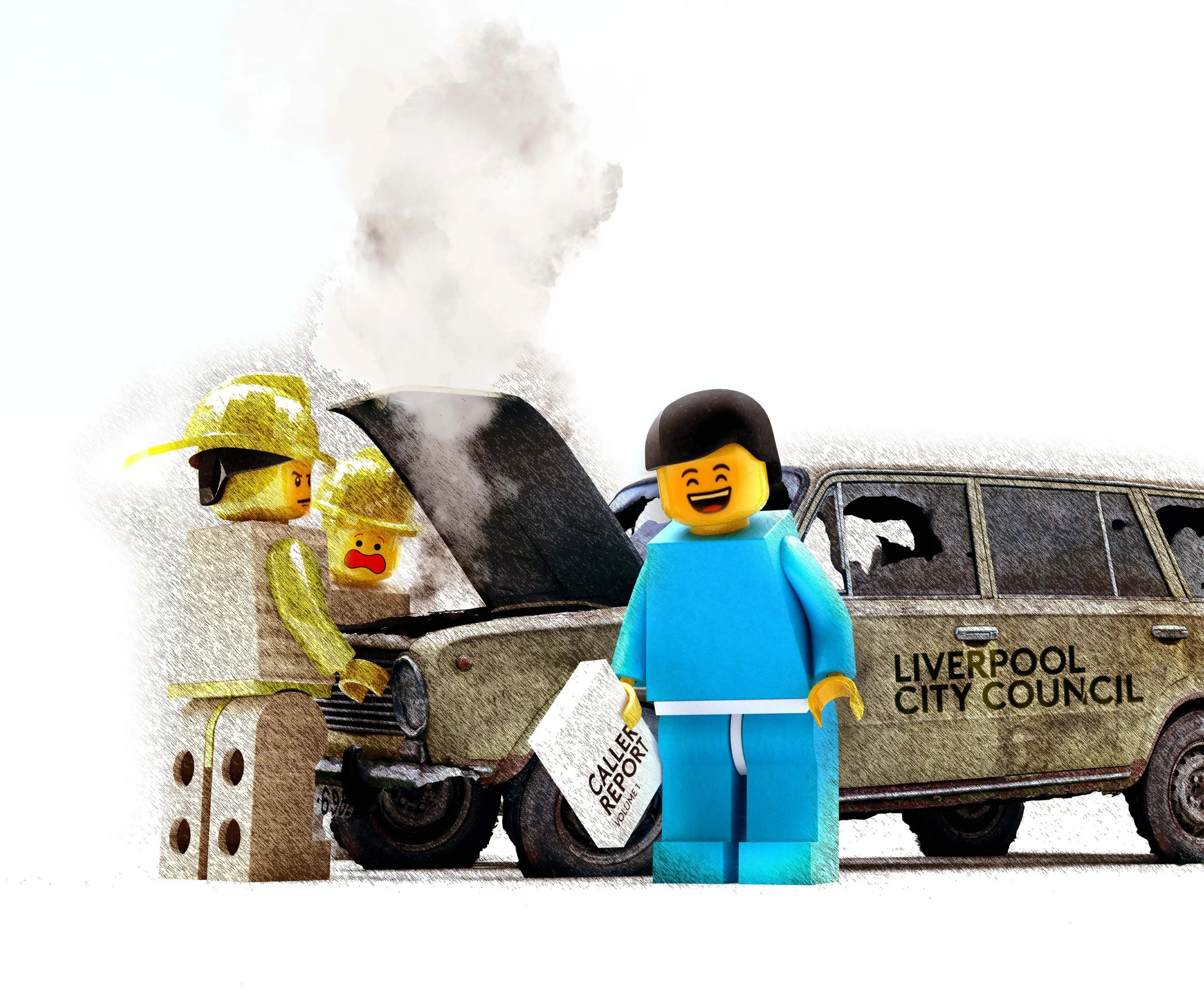Recent features
A new central Liverpool
As a youngster I’d often be dragged kicking and screaming into ‘town’ by my mother, first from Aigburth and later Speke on the 82 bus for a day traipsing around central Liverpool. The delights of these trips would include Solitaire, Dodo’s and Miss Selfridges (all high street names now consigned to the past) and we would start this bonanza at Lewis’ department store, jumping off the bus and into the throng of Saturday morning shoppers. We’d cut through Lewis’ giant store before heading to what was then the newly opened Clayton Square shopping centre and a supposedly refreshed green-glass clad St Johns Centre. From there the misery of shopping with your mum on a Saturday would commence.
Michael McDonough
As a youngster I’d often be dragged kicking and screaming into ‘town’ by my mother, first from Aigburth and later Speke on the 82 bus for a day traipsing around central Liverpool.
The delights of these trips would include Solitaire, Dodo’s and Miss Selfridges (all high street names now consigned to the past) and we would start this bonanza at Lewis’ department store, jumping off the bus and into the throng of Saturday morning shoppers. We’d cut through Lewis’ giant store before heading to what was then the newly opened Clayton Square shopping centre and a supposedly refreshed green-glass clad St Johns Centre. From there the misery of shopping with your mum on a Saturday would commence.
For me it was my first introduction to a big city centre alongside the odd jaunt over to Manchester and it was where I began to really think about architecture and the built environment. I’d see the different building styles and the variety of scale and begin to understand what fundamentally makes a city centre feel vibrant and appealing. Of course, today I’m a bit more travelled but I still think central Liverpool retains a bizarre and unique mix of architecture and energy that few European cities can rival.
Sadly today, Liverpool’s optimistic 1960’s shopping centre architecture and MDF pre-fab station retail (Liverpool Central) is all looking incredibly tired, like a patched up old car that’s had multiple uncaring owners. It still functions but it doesn’t look too good aesthetically.
Let’s take St Johns Centre, the largest indoor shopping centre in the city, squatting as it does right next to Liverpool’s front door to the world - Lime St. It’s also directly adjacent to some of the world’s finest neo-classical architecture such as St Georges Hall. This shopping behemoth, designed by architect James A. Roberts, landed ungraciously on the city in 1969 and has suffered two fires and several re-clads, leaving us with a mish mash of hasty spruce-up’s from owners who have lacked the deep pockets to do anything truly worthwhile.
The Centre itself was actually a much smarter affair when it first opened, before it was mauled by those who, in the 1990’s, thought faux-Victorian brick features would add a dash of sophistication. Still, in its defence St Johns remains very profitable for it’s owners, and this is likely the reason why it continues to squat on what should be a prime city centre site - a pound shop paradise instead of a Gucci-style emporium. It’s not all bad though, we were also gifted St Johns Beacon in 1969 as a glorified chimney to ventilate the centre. Better known today as the Radio City Tower, it’s become a landmark in itself, but also architectural marmite. Shorter than was originally intended, it’s short-lived rotating restaurant feature has long-since closed with its crown now defaced with radio antennae. Recently it was threatened with a quite frankly ridiculous zip wire proposal that would have seen the more adventurous amongst us flung across St Georges Hall before landing on top of the Liverpool Central Library, but thankfully, the subsequent uproar consigned the scheme to Liverpool City Council’s rather large book of planning mistakes.
St Johns Centre as viewed from St Georges Hall, 2020.
Clayton Square (left) and St Johns Centre (right), 2020.
St Johns is sadly not alone across this axis of tat that defaces central Liverpool. There is also the now, in my view, ruined Clayton Square. You might notice that I don’t refer to it as a ‘shopping centre’ because today it is a far cry from its intended design, having been boxed up internally for long standing retail anchor Boots the Chemist. The original grand and spacious feel of the 1990’s glass-covered mall lost behind MDF wall panels. The only redeeming feature of Clayton Square is its distinctive glass dome as a reminder of what once was. Again, the victim of a visionless ownership doing the bare minimum, this once impressive shopping centre has been turned into a forgettable cut-through.
Sadly today, Liverpool’s optimistic 1960’s shopping centre architecture and MDF pre-fab station retail (Liverpool Central) is all looking incredibly tired,…
The rap sheet of poor developments goes on…there’s the now wrecked former Blacklers store populated at ground level by the Wetherspoons pub chain and greasy low-end fast food joints. The unforgivebly bland and beige ION student accomodation scheme which replaced the Futurist (a building that still needed to go as it was collapsing). Its depressing cladded hulk hiding the even more depressing breeze block, creaking floor misery that is the Student ‘Castle’ behind. Then there’s the decaying former ABC art deco cinema on the opposite side of the road that has also fallen victim to numerous false dawns including plans to turn it into a TV studio. And who could forget the Holiday Inn towering above St Johns? For some bizarre reason, the hotel was painted black with white window frames and now provides a nice clean target for seagulls offloading their mess quite visibly across the facade, a delight I’m sure for those arriving at Lime St for the first time. But the pièce de resistance has to be the blue plastic cover stretching around the St Johns Centre car park as an apologetic gesture from the city leaders, who are all too aware of how much of an embarrassing eyesore this part of the city has become. No amount of repaving is going to fix that one.
I should stop there as the horrors of Williamson and Queens Squares with their out of town retail architecture are too much to bare. Even the entrance to Liverpool Central station and shopping centre is a sorry indictment of how quick the city is to demolish great architecture and replace it with worse. Too little is invested in Liverpool’s transport infrastructure today. If this was London, things would look very different.
Anyway, that’s enough of the critical; let’s move on to the constructive! At Liverpolitan, when it comes to architecture and urban design we at least like to have a stab at putting our money where our mouth is and so we’ve visualised what central Liverpool could potentially look like with a major, joined up and comprehensive redevelopment plan akin to Liverpool One.
The featured visuals explore how a forward-thinking city administration, alongside some ambitious local politicians and business leaders might take central Liverpool forward. The designs imagine a city centre unlocked from the obstructive mess that indoor shopping centres have created and moves instead to individual buildings and re-instated streets. Those buildings play host, not to the bargain basement, but to hotels, much needed Grade A flexible office and event spaces, small and medium-sized businesses. There’s also a leisure and media hub, landmark building to replace Clayton Square and ground-level, accessible market space to replace St Johns Market, now relocated to Williamson Square with the potential for it to spill out into the surrounding streets.
A re-imagined St Johns Beacon.
We imagine a new central Liverpool anchored by a new transport hub with a major expansion of Liverpool Central station returning this increasingly overcrowded and underinvested underground station in to something more in line with its former role as a national gateway with the completion of the Edge Hill Spur scheme to tunnel the Northern line out to Edge Hill and beyond (we’ll have an article on that at some point).
New and re-instated street connections between Queens Square and Central Station offer a clear line of sight through to the St Georges Hall portico. Rather than repeat the mistakes of St Johns, which for want of a better phrase, turned its architectural ‘arse’ to one of our grandest buildings, new structures will offer a proud face towards it. It’s almost as if architects in the 1960’s dismissed St Georges Hall as some imperialist soot-covered beast that would soon be demolished, and so contextually didn’t matter. Bulldozers were on the cards for Lime St’s Great Northwestern Hotel frontage, it it wasn’t for a campaign to stop them.
The design concepts envisage a far more porous central Liverpool with a new green space, elevated across several levels, looking out across St Georges Plateau. Hopefully it would act as an invitation to the now sad and disconnected lower London road to join the re-development party and come back into the city centre fold. Scale and world class architectural design would be the order of the day much like Liverpool One. Instead of leaving such an important project in the hands of a clique of local developers practice on a budget, International competitions would invite the world’s best to compete. Let the best designs and those with the best track records win out.
Lewis’, the former Blackers Store and the remaining streets between would all be spurred on to step-up and re-invent themselves. The result? A whole, new beating heart for central Liverpool, far more befitting of where the city wants and needs to be. A statement to anyone arriving at Lime St Station that Liverpool is a world class city that respects its heritage, but is determined to do everything it can to match and surpass its history. One that thinks bigger, and better.
It would be nice to get off the 82 bus one day and walk through a vibrant, modern central Liverpool - a place without chewing gum ridden pavements and hot dog stands. Liverpool One still set’s the bar for city centre regeneration. We did it before, we can do it again.
Michael McDonough is the Art Director and Co-Founder of Liverpolitan. He is also a lead creative specialising in 3D and animation, film and conceptual spatial design.
Share this article
Where’s our levelling up, Whitehall…?
If you’ve had the good sense to avoid much of the news media over the last year, one of the major political announcements beyond the pandemic has been that of major relocations of the Civil Service from London to the regions. The so-called ‘levelling up’ agenda is the narrative driving this major change in policy and we’ve been watching keenly ever since to discover how ambitiously and fairly it is being implemented. This is clearly long overdue in a nation that is one of the most politically and economically centralised countries in the western world, and comes 15 years after it was last seriously discussed following the Lyons Review, which largely failed to deliver any meaningful change.
Liverpolitan Contributor
If you’ve had the good sense to avoid much of the news media over the last year, one of the major political announcements beyond the pandemic has been that of major relocations of the Civil Service from London to the regions.
The so-called ‘levelling up’ agenda is the narrative driving this major change in policy and we’ve been watching keenly ever since to discover how ambitiously and fairly it is being implemented. This is clearly long overdue in a nation that is one of the most politically and economically centralised countries in the western world, and comes 15 years after it was last seriously discussed following the Lyons Review, which largely failed to deliver any meaningful change. Opponents of the idea usually point to the Office for National Statistics move to Newport, which failed to generate much of a boost to its local economy, but I’m not sure what they really expected from relocating such a specific service function to a mid-sized city with little potential to leverage commercial multiplier benefits. Other relocations of civil service jobs and functions have shown limited success due to them effectively being the outsourcing of lower grade roles rather than senior policymakers with real influence. The Government’s own statistics show that over two-thirds of the most senior civil servants remain based in London.
Before we explore this theme further, one of the many impacts of the pandemic has been to change where people want to live and work. This is not to argue that traditional offices, or the town and city centres where they are located, are set for a prolonged demise. Far from it. Offices will continue to thrive as centres for work, but in a repurposed way that maximises a more flexible, collaborative and agile working culture. But increasingly, London does appear to be falling out of favour. Over the last year many thousands of people have escaped the capital for a better quality of life in towns, cities and villages all over the UK. This includes many who have moved back to the Liverpool Metropolitan Region, so it was no surprise to read a recent article in This is Money showing that house price growth in Liverpool over the last 12 months has been the highest of any city in the UK, and more than five times that of London. There are numerous reasons for this, but one significant contributing factor is undoubtedly people escaping the high prices of the capital to return back to where they grew up or attended university. One could describe this as a reversing of the brain-drain effect that all cities have suffered to London over many decades.
Location of Senior Civil Service roles
Source: Moving Out: Making A Success of Civil Service Relocation; IFG Insight November 2020; Institute For Government
There is no doubt that the Liverpool Metropolitan Region has a compelling case for people to relocate to as a great place to live and work. It’s human nature for us to be drawn to water, so the great natural assets we have in the River Mersey, Wirral peninsula and the miles of beaches and sand-dunes on the Sefton coast are a huge draw. Only a little further afield - a mere stones-throw away - lies the mountains and coastlines of North Wales. Then there is the depth of the arts and culture scene and their institutions, quite possibly unmatched in any other city outside London. Liverpool is probably the most architecturally significant regional city, with more listed buildings than any other, and is home to many beautiful parks. It also has a thriving independent food scene and a nightlife that is frequently regarded as the best in the UK. There is good reason why the people who visit Liverpool often come back time and time again. The start of this shift in focus away from the capital is hugely important to our nation and its economic and cultural future.
Back to the levelling up agenda, and it’s worth considering the moves of the BBC. Although not directly controlled by the state, large swathes of the institution have already upped and moved to Manchester/Salford over the last decade to ‘benefit the North’. It now provides jobs and opportunities for more than 3000 people in that city region and has added significant multiplier benefits to its local economy. Currently, the BBC only employs around 30 people in the Liverpool Metropolitan Region, although there is some talk that they might open a small training hub both here and in Hull. This is a matter which I’m sure we’ll come back to in the future. Meanwhile, back in 2018, there was the competition between the major regional cities to secure the new Channel 4 HQ, a selection process which did not give the impression of being particularly fair or transparent. Although the government does not get to tell these organisations where to move, as publicly-owned bodies their decision-making often follows the political theme and thought processes of the day.
The start of this shift in focus away from the capital is hugely important to our nation and its economic and cultural future.
What department relocations have been announced so far?
In recent months, we have seen news of a new Treasury campus being established in Darlington, albeit with a little nod and wink from Rishi to his Conservative Tees Valley Metro Mayor friend, Ben Houchen. Meanwhile, Leeds was gifted the UK Infrastructure Bank plus a new Bank of England hub, both of which are likely to provide an extremely positive influence on the prosperity of that city and its suburbs. In time, we’ll see how evenly the funds it distributes are spread around the nation. More recently, the Department for Business, Energy and Industrial Strategy (BEIS) announced increases in its regional headcount, with Birmingham and Salford/Manchester being by far the greatest beneficiaries. The Ministry of Housing Communities and Local Government (HCLG) is moving to Wolverhampton. Peterborough will also secure over a thousand new roles from the HM Passport Office and the Department for the Environment.
What does that leave left for the other large cities so far overlooked?
The fear is that the bigger prizes are already gone. Recently, the Leeds-based think tank the Northern Policy Foundation graded all of the major northern urban areas on their overall suitability for large-scale relocations. Liverpool scored rather well. It then went on to suggest suitable locations for departments based on seven grading indexes. Defence in Preston, Education in Lancaster, Crime to Newcastle, Infrastructure in Warrington, and then Liverpool as the most appropriate location for the various Health and NHS Departments. This was partly based on the city having more specialist hospitals than any other outside London, its research-intensive universities (notably the University of Liverpool and School of Tropical Medicine) and one of the largest biopharmaceutical manufacturing clusters in Europe. It’s hard to disagree with any of that. But what else could we have on our ‘levelling up equitably’ list’?
Department of Culture, Media and Sport
Liverpool has a rich history and expertise in both culture and sport. In 2008, the city of Liverpool was awarded the prestigious title of the European Capital of Culture and, according to our local leaders, encouraged by central and regional government to focus on culture and tourism rather than business to drive future prosperity. As unthinkable as that strategy is to most intelligent people, for the Government to not award this department here would be a huge disappointment. And media? This is an area where the Liverpool Metropolitan Region is seriously underserved, but housing that Government function here could provide some counterbalance to the poor treatment the city region and its people have suffered at the hands of regional and national media over many decades. Perception is critical to any region’s prosperity and with better representation we’d hope to see a gradual improvement in the way media institutions depict our region. A more equal playing field would also provide opportunities for our future generations.
Department for Transport
I won’t go into the hugely damaging side-lining of the Liverpool Metropolitan Area by HS2. That will no doubt feature elsewhere. Nor that Liverpool is statistically the poorest connected out of all the core cities by rail. But, over the last 20 years many other regional cities have benefitted from significant amounts of capital expenditure with whole new tram systems, new railway routes and underground lines. Although we have a local rail network in Merseyrail that is the envy of many others, having to wait 10 years for each new (typically small-scale suburban) station seems more like levelling down and does a huge injustice to a network that covers an area of nearly 2 million people. Would such disparity be allowed if the government department responsible for it made its home in the place it has seemingly ignored for so long?
The above are, perhaps the most obvious examples, but there are others that we could make a genuine and compelling case for…
National Cyber Force
It has already been announced that this new function will have a permanent new base in the North West of England in a so-called ‘cyber corridor’. With Manchester already having been gifted a new outpost for GCHQ, including its Accelerator programme, as well as other support to the local business community, surely locating the new National Cyber Force in the Liverpool Metropolitan Region is right to achieve levelling up fairly? We are already home to a thriving tech and start-up scene. Our four universities develop large numbers of quality graduate talent. And with large historical and civil service links to the Ministry of Defence, it would seem entirely logical and equitable.
Advanced Research and Invention Agency (ARIA)
As well as a leading research-intensive university and health and biotech sectors, the Liverpool Metropolitan Region is also a leading player in advanced manufacturing and robotics, and is home to The Hartree Centre, a research facility for the advanced high-performance computing, data analytics and artificial intelligence (AI), which is based in Halton. It is well known in university circles that those in London and the South have traditionally secured greater allocations of research funding and investment than those in northern cities. It was at the time of the new Millennium that the Government took the decision to move the Synchrotron Radiation research facility from Daresbury to Oxfordshire, along with £500m of investment that came with it, so maybe now it’s time to correct the mistakes of the past and truly level up…



































